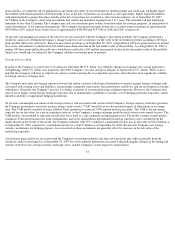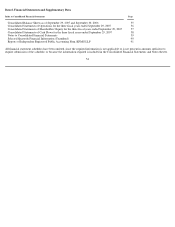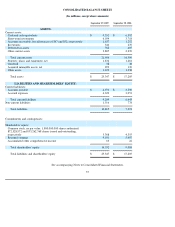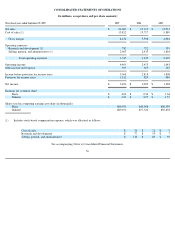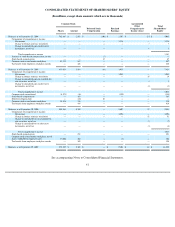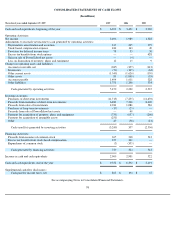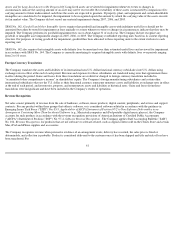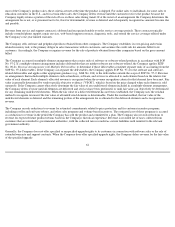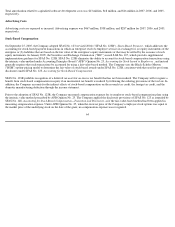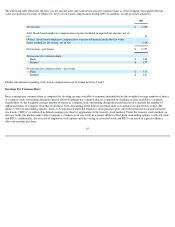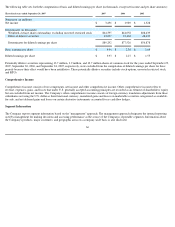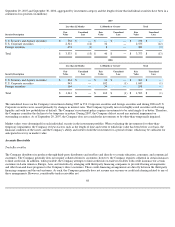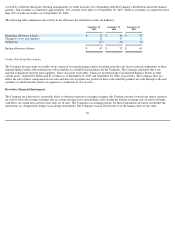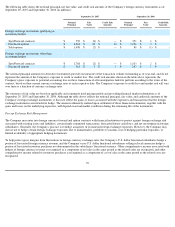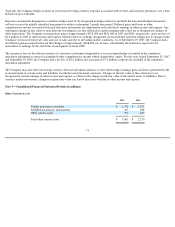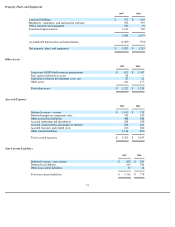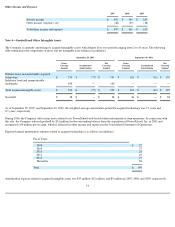Apple 2007 Annual Report Download - page 67
Download and view the complete annual report
Please find page 67 of the 2007 Apple annual report below. You can navigate through the pages in the report by either clicking on the pages listed below, or by using the keyword search tool below to find specific information within the annual report.
right until the future obligation is fulfilled or when the right to the specified upgrade expires. Additionally, a limited number of the Company's
software products are available with maintenance agreements that grant customers rights to unspecified future upgrades over the maintenance
term on a when and if available basis. Revenue associated with such maintenance is recognized ratably over the maintenance term.
In March 2007, the Company began shipping Apple TV and in June 2007 began shipping iPhone. For Apple TV and iPhone, the Company
indicated it may provide future unspecified features and additional software products free of charge to customers. Accordingly, Apple TV and
iPhone handsets sales are accounted for under subscription accounting in accordance with SOP No. 97-2. As such, the Company's policy is to
defer the associated revenue and cost of goods sold at the time of sale, and recognize both on a straight-line basis over the currently estimated
24-month economic life of these products, with any loss recognized at the time of sale. Costs incurred by the Company for engineering, sales,
marketing and warranty are expensed as incurred.
Allowance for Doubtful Accounts
The Company records its allowance for doubtful accounts based upon its assessment of various factors. The Company considers historical
experience, the age of the accounts receivable balances, credit quality of the Company's customers, current economic conditions, and other
factors that may affect customers' ability to pay.
Shipping Costs
For all periods presented, amounts billed to customers related to shipping and handling are classified as revenue, and the Company's shipping
and handling costs are included in cost of sales.
Warranty Expense
The Company generally provides for the estimated cost of hardware and software warranties at the time the related revenue is recognized. The
Company assesses the adequacy of its preexisting warranty liabilities and adjusts the amounts as necessary based on actual experience and
changes in future estimates. For products accounted for under subscription accounting pursuant to SOP No. 97-2, the Company recognizes
warranty expense as incurred.
Software Development Costs
Research and development costs are expensed as incurred. Development costs of computer software to be sold, leased, or otherwise marketed are
subject to capitalization beginning when a product's technological feasibility has been established and ending when a product is available for
general release to customers pursuant to SFAS No. 86, Computer Software to be Sold, Leased, or Otherwise Marketed . In most instances, the
Company's products are released soon after technological feasibility has been established. Therefore, costs incurred subsequent to achievement
of technological feasibility are usually not significant, and generally most software development costs have been expensed.
In 2007, the Company determined that both Mac OS X Version 10.5 Leopard ("Mac OS X Leopard") and iPhone achieved technological
feasibility. During 2007, the Company capitalized $75 million of costs associated with the development of Leopard and iPhone. In accordance
with SFAS No. 86, the capitalized costs related to Mac OS X Leopard and iPhone are amortized to cost of sales commencing when each
respective product begins shipping and are recognized on a straight-line basis over a 3 year estimated useful life of the underlying technology.
63


